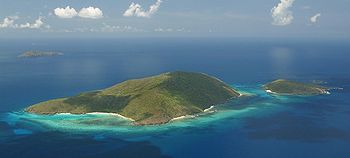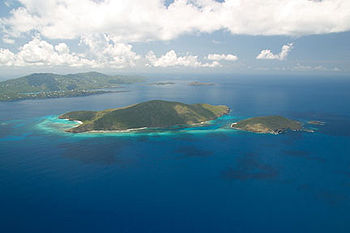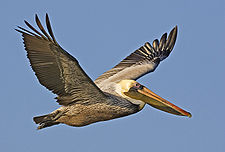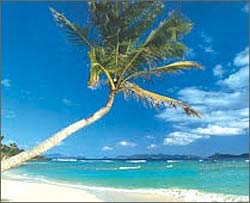
Hans Lollik Island
Encyclopedia

United States Virgin Islands
The Virgin Islands of the United States are a group of islands in the Caribbean that are an insular area of the United States. The islands are geographically part of the Virgin Islands archipelago and are located in the Leeward Islands of the Lesser Antilles.The U.S...
. The islands,which are currently for sale, are owned by film producer Bruce Randolph Tizes and his male partner Peter R. Morris. Great Hans Lollik Island ("GHL") is found approximately 8,000 feet (2½ km) beyond the central northshore of St. Thomas
Saint Thomas, U.S. Virgin Islands
Saint Thomas is an island in the Caribbean Sea and with the islands of Saint John, Saint Croix, and Water Island a county and constituent district of the United States Virgin Islands , an unincorporated territory of the United States. Located on the island is the territorial capital and port of...
, US Virgin Islands
United States Virgin Islands
The Virgin Islands of the United States are a group of islands in the Caribbean that are an insular area of the United States. The islands are geographically part of the Virgin Islands archipelago and are located in the Leeward Islands of the Lesser Antilles.The U.S...
, separated from St. Thomas by the Leeward Passage
Leeward Passage
The Leeward Passage is a channel between Hans Lollik Island and northern St. Thomas Island in the United States Virgin Islands in the West Indies.-References:...
. Little Hans Lollik and Pelican Cay lie to the north of Hans Lollik on the same shelf. The major part of the benthic zone
Benthic zone
The benthic zone is the ecological region at the lowest level of a body of water such as an ocean or a lake, including the sediment surface and some sub-surface layers. Organisms living in this zone are called benthos. They generally live in close relationship with the substrate bottom; many such...
around Hans Lollik is rocky and supports a dense diverse coral
Coral
Corals are marine animals in class Anthozoa of phylum Cnidaria typically living in compact colonies of many identical individual "polyps". The group includes the important reef builders that inhabit tropical oceans and secrete calcium carbonate to form a hard skeleton.A coral "head" is a colony of...
habitat.
Terrestrial features
The terrestrial features of the Hans Lollik group are functions of their natural topographyTopography
Topography is the study of Earth's surface shape and features or those ofplanets, moons, and asteroids...
, exposure to trade winds, and consequences of human occupation. In part because of its low elevation, GHL receives about 44 inches (1,120 mm) of rainfall annually. The east and northeast slopes experience regular northeasterly trade wind
Trade wind
The trade winds are the prevailing pattern of easterly surface winds found in the tropics, within the lower portion of the Earth's atmosphere, in the lower section of the troposphere near the Earth's equator...
s. The leeward hillsides and guts retain more moisture and support plant communities that differ from those on windward slopes in growth form and species
Species
In biology, a species is one of the basic units of biological classification and a taxonomic rank. A species is often defined as a group of organisms capable of interbreeding and producing fertile offspring. While in many cases this definition is adequate, more precise or differing measures are...
composition.
Human occupation has had a significant impact on the ecology of the island. From the early 18th century to the 1850s, the Virgin Islands were clear-cut and farmed. Local historians estimate that about 30 to 40 acres (12 to 16 ha) of GHL was cultivated for cotton
Cotton
Cotton is a soft, fluffy staple fiber that grows in a boll, or protective capsule, around the seeds of cotton plants of the genus Gossypium. The fiber is almost pure cellulose. The botanical purpose of cotton fiber is to aid in seed dispersal....
during this period. The steep profile of the island caused exposed soil to creep and wash into the sea as sediment run-off; some estimate that several feet of topsoil
Topsoil
Topsoil is the upper, outermost layer of soil, usually the top to . It has the highest concentration of organic matter and microorganisms and is where most of the Earth's biological soil activity occurs.-Importance:...
were lost during this agricultural period. In the 1940s and 1950s, GHL was logged for timber
Timber
Timber may refer to:* Timber, a term common in the United Kingdom and Australia for wood materials * Timber, Oregon, an unincorporated community in the U.S...
which was sold in St. Croix, U.S. Virgin Islands. While only donkeys, and European rabbits remain on the island, goats also occupied the island in the past years.
The legacy of modern human occupation of Hans Lollik has produced an island dissimilar to that seen by the Arawak prior to the island’s discovery by Europeans (at the end of the 15th century). Clear-cutting, burning, and logging have modified the island’s vegetation. Seed stock for species once present on the island no longer exists locally. Fire allowed resistant species (e.g., thatch palm
Thatch palm
The name Thatch palm is applied to several different species of palm trees in the genera Coccothrinax, Howea and Thrinax. The name comes from the use of these trees for roof thatching....
) to dominate, and logging left stock for a future forest canopy dominated by softwoods (e.g., loblolly pine
Loblolly Pine
Pinus taeda is one of several pines native to the Southeastern United States, from central Texas east to Florida, and north to Delaware. It is particularly dominant in the eastern half of North Carolina, where there are huge expanses consisting solely of Loblolly Pine trees...
, blolly, and Geiger tree
Geiger tree
Cordia sebestena is a species of flowering plant in the borage family, Boraginaceae.It is native to the American tropics, from southern Florida in the United States and The Bahamas southwards throughout Central America and the Greater Antilles...
). Concomitantly, settlers introduced exotic species and cultivars, some of which spread and now dominate present plant communities on the island.

Animal life
No native terrestrial mammals occur on either of Great Hans Lollik or Little Hans Lollik. The black ratBlack Rat
The black rat is a common long-tailed rodent of the genus Rattus in the subfamily Murinae . The species originated in tropical Asia and spread through the Near East in Roman times before reaching Europe by the 1st century and spreading with Europeans across the world.-Taxonomy:The black rat was...
(Rattus rattus) was introduced by early European settlers within the last 500 years. The European Rabbit
European Rabbit
The European Rabbit or Common Rabbit is a species of rabbit native to south west Europe and north west Africa . It has been widely introduced elsewhere often with devastating effects on local biodiversity...
(Oryctolagus cuniculus), cat
Cat
The cat , also known as the domestic cat or housecat to distinguish it from other felids and felines, is a small, usually furry, domesticated, carnivorous mammal that is valued by humans for its companionship and for its ability to hunt vermin and household pests...
s (Felis cattus) and donkey
Donkey
The donkey or ass, Equus africanus asinus, is a domesticated member of the Equidae or horse family. The wild ancestor of the donkey is the African Wild Ass, E...
s (Equus asinus) have been intentionally released. There should be four native species of bats present: Noctillio jeporinus (a fishing bat), Molossus molossus (a small insectivore), Jamaican fruit bat
Jamaican fruit bat
The Jamaican, Common or Mexican fruit bat is a fruit bat native to Central and South America, as well as the Greater and many of the Lesser Antilles. It is also an uncommon resident of the Southern Bahamas...
Artibeus jamaicensis, and Antillean Fruit-eating Bat
Antillean Fruit-eating Bat
The Antillean Fruit-eating Bat is one of two leaf-nosed bat species belonging to the Brachyphylla genus. The species occurs in the Caribbean from Puerto Rico to St. Vincent and Barbados. Fossil specimens have also been recorded from New Providence, Bahamas.-Taxonomy:Three subspecies of...
Brachyphylla cavernarum (a pollen and nectar feeder).
Reptiles and amphibians
The herpetofauna of Hans Lollik has not been well studied, but species composition should closely resemble that of St. Thomas. Several species of lizards, common on nearby islands, have never been documented on Hans Lollik. During a 1990s survey, sight records of three previously unrecorded reptiles were established: two lizards (Ameiva exul and Anolis pulchellus) and a snake (Liophis portoricensis). Another lizard, Anolis stratulus, was collected for the first time. Lizards previously documented include: Anolis critatellus and Sphaerodactylus macrolepus.Based on their distribution and habitat requirements on surrounding islands, one might expect the following species to be present as well: Iguana iguana, Hemidactylus mabouia, Mabuya mabouya
Mabuya mabouya
Mabuya mabouya is a species of skink found on certain islands in the Caribbean. It has shiny, bronze-colored skin, with a pair of light stripes that run along its upper flanks....
, and Amphisbaena fenestrata
Amphisbaena fenestrata
Amphisbaena fenestrata, known commonly as the Virgin Islands worm lizard is a worm lizard species in the genus Amphisbaena....
. Iguana pinguis, a species endemic to the Puerto Rico Bank, has been extirpated from most developed islands in the region, but might survive on one or more of the islands in the study area. Two snakes found on St. Thomas might occur on Hans Lollik: Typhlops richardii
Typhlops richardii
Typhlops richardii, or Richard's blind snake, is a species of snake in the Typhlopidae family....
and Liophis exequuis. Liophis portoricensis (a lizard-eating ground snake) has been reduced in numbers or extirpated on the large islands within its range. Geochelone carbonaria, the red-legged tortoise, has not been recorded but may be present.
No amphibians are known to live on Hans Lollik, but it is possible that one or more species of cocqui (Eleutherodactylus
Eleutherodactylus
Eleutherodactylus is a genus of frogs in the Leptodactylidae family. It is typically described as the largest vertebrate genus on Earth, with over 700 species...
) occurs there. These tiny frogs create foam nests to protect their eggs and tadpoles
Tadpoles
Tadpoles are a psychedelic rock band formed in 1990 in New York City by Todd Parker , Michael Kite Audino and Josh Bracken In 1992, Nick Kramer , David Max and Andrew Jackson of the fledgling Manhattan group, Hit, joined the Tadpoles after putting Hit on hiatus.In 1993 Kite and Jackson left the...
from desiccation
Desiccation
Desiccation is the state of extreme dryness, or the process of extreme drying. A desiccant is a hygroscopic substance that induces or sustains such a state in its local vicinity in a moderately sealed container.-Science:...
and standing freshwater
Freshwater
Fresh water is naturally occurring water on the Earth's surface in ice sheets, ice caps, glaciers, bogs, ponds, lakes, rivers and streams, and underground as groundwater in aquifers and underground streams. Fresh water is generally characterized by having low concentrations of dissolved salts and...
is not required for reproduction while adult frogs hide in damp areas, such as the leaf bases of bromeliads, to avoid xeric conditions.
Avifauna
Many bird species are seasonal visitors to the offshore cays and are only in evidence at Hans Lollik during the summer breeding season. The most conspicuous birds at the study sites are the resident seabirdSeabird
Seabirds are birds that have adapted to life within the marine environment. While seabirds vary greatly in lifestyle, behaviour and physiology, they often exhibit striking convergent evolution, as the same environmental problems and feeding niches have resulted in similar adaptations...
species, including the brown booby
Brown Booby
The Brown Booby is a large seabird of the booby family, Sulidae. The adult brown booby reaches about in length. Its head and upper body are covered in dark brown, with the remainder being a contrasting white. The juvenile form is gray-brown with darkening on the head, wings and tail...
(Sula melanogaster) and the brown pelican
Brown Pelican
The Brown Pelican is the smallest of the eight species of pelican, although it is a large bird in nearly every other regard. It is in length, weighs from and has a wingspan from .-Range and habits:...
(Pelecanus occidentalis). Both species utilize the bait-rich waters of Hans Lollik for feeding; both species target white fry, blue fry, or false pilchard as preferred prey. The prime roosting spots for these species have been located and mapped by JDA
JDA
JDA may refer to:*Janne Da Arc, a Japanese rock group*Japan Defense Agency*Japan Dental Association*JDA Software, software house and parent company of Manugistics*Jersey Democratic Alliance*DJ J.D.A., a Dutch gabber DJ...
to enable the site planning process to avoid these areas. Hans Lollik has no critical nesting sites for any bird species. The cliff-site nesting areas for the tropic bird are de facto protected from humans by their precarious cliff location.

Brown Pelican
The Brown Pelican is the smallest of the eight species of pelican, although it is a large bird in nearly every other regard. It is in length, weighs from and has a wingspan from .-Range and habits:...
-nesting site, and the sparse nesting which now occurs is opportunistic. This nesting may well be the result of a booming local population of pelicans, which is spreading out to new roosting and nesting sites, or it may be the result of displacement from other islands and cays. The brown pelican is listed as endangered, both federally and by the Virgin Islands. The brown pelican was once thought to be doomed due to the eggshell-thinning events brought about by DDT
DDT
DDT is one of the most well-known synthetic insecticides. It is a chemical with a long, unique, and controversial history....
contamination. Since the DDT ban went into effect, brown pelican populations throughout the US have recovered, causing the species to be delisted throughout much of its range. The southeast U.S. (including Virgin Islands) populations have not yet been delisted, but indications are that these populations are also recovering.
Noddy terns (Anous stolidus), least terns (Sterna albifrons), sooty tern
Sooty Tern
The Sooty Tern, Onychoprion fuscatus , is a seabird of the tern family . It is a bird of the tropical oceans, breeding on islands throughout the equatorial zone. Colloquially, it is known as the Wideawake Tern or just wideawake...
s (Sterna fuscata), and royal tern
Royal Tern
The Royal Tern is a seabird in the tern family Sternidae. This bird has two distinctive subspecies. T. m. maximus breeds on the Atlantic and Pacific coasts of the southern USA and Mexico into the Caribbean. The slightly smaller T. m. albididorsalis breeds in coastal west Africa...
s (Thalasseus maximus) have all been recorded as nesting on nearby Pelican Cay, but not on Hans Lollik Island. Other bird species seen on Hans Lollik include the ubiquitous pearly-eyed thrasher (Margarops fuscatus), the bananaquit
Bananaquit
The Bananaquit is a species of passerine bird of uncertain relation. It is tentatively placed in the tanager family, but classified as incertae sedis by other authorities such as the American Ornithologists' Union. Its classification is debated, and it is often placed in its own family: Coerebidae...
(Coeroba flaveloa), the oystercatcher
Oystercatcher
The oystercatchers are a group of waders; they form the family Haematopodidae, which has a single genus, Haematopus. They are found on coasts worldwide apart from the polar regions and some tropical regions of Africa and South East Asia...
(Haematopus pallitus), and the sparrowhawk
American Kestrel
The American Kestrel , sometimes colloquially known as the Sparrow Hawk, is a small falcon, and the only kestrel found in the Americas. It is the most common falcon in North America, and is found in a wide variety of habitats. At long, it is also the smallest falcon in North America...
(Falco sparverius).
Benthic features
The area between Hans Lollik and Little Hans Lollik is relatively shallow and is primarily a hard bottom with scattered large patches of sand and cobble. Currents flowing between the two islands are generally to the west, and are often quite swift. The shallows along the shores of both islands are colonized by head corals, Diplora strigosa, D. clivosa, Sidereastrea siderea, D. labyrinthiformis, Colpophyllia natansColpophyllia natans
Colpophyllia natans, known as boulder brain coral and large-grooved brain coral, is a species of stony coral found primarily in the Caribbean Sea and the Gulf of Mexico. It inhabits the slopes and tops of reefs, to a maximum depth of fifty metres...
, Porites astreoides
Porites astreoides
Porites astreoides is a coral that belongs to the genus Porites. The common name is the mustard hill coral.- References :* *...
, Montastrea annularis, M. cavernosa and Dendrogyra cylindrus. There are scattered elkhorn coral Acropora palmata, and staghorn coral A. cervicornis. In the shallower areas, less than 10 ft (3 m) most of the Acropora
Acropora
Acropora is a genus of scleractinian coral in the Phylum Cnidaria. Some of its species are known as table coral, elkhorn coral and staghorn coral. There are currently 149 described species...
is alive, while deeper there are numerous skeletons of these once massive spreading corals. There are also some very large remnants of Porites porites colonies that lie between the two islands. Some of these mounds are 10 to 12 ft (3 to 4 m) in height and width. Agarcia, Millepora, P. porites, and a variety of sponge species have colonize the dead coral of these mounds. The entire area is destiny colonized by soft coral species and sea plumes, fans feathers are scattered throughout. To the southwest there is a sandy beach, and the sand extends offshore into the bentic environment. Within this sandy area there are emergent areas of rock that have become colonized by corals (Siderastrea and Diplora) and algae. Further offshore there is shallow reef area that is highly impacted by the on coming waves. The reef area supports of variety of soft and hard coral colonization. Along the western side of the island and along the northwestern tip the shoreline is rocky, and the rock extends below the sea. There are large boulders and slabs of rock that lie just below the waters surface along the shore. A diverse community of corals and sponges colonizes this rock substrate that rapidly drops to a depth of 20 to 25 ft (6 to 8 m). Head corals (Diplora strigosa, D. clivosa, Sidereastrea siderea, D. labyrinthiformis, Colpophyllia natans, Porites astreoides, Montastrea annularis, M. cavernosa and Dendrogyra cylindrus), branching corals (Acropora palmate, A cervicornis, Porites porites), and fire corals (Millepora spp.) are common within this area.
Cetaceans and other marine species
The most common cetacean species to move through the waters of the greater Hans Lollik area include bottlenose dolphinBottlenose Dolphin
Bottlenose dolphins, the genus Tursiops, are the most common and well-known members of the family Delphinidae, the family of oceanic dolphins. Recent molecular studies show the genus contains two species, the common bottlenose dolphin and the Indo-Pacific bottlenose dolphin , instead of one...
s (Tursiops truncatus) and humpback whale
Humpback Whale
The humpback whale is a species of baleen whale. One of the larger rorqual species, adults range in length from and weigh approximately . The humpback has a distinctive body shape, with unusually long pectoral fins and a knobbly head. It is an acrobatic animal, often breaching and slapping the...
s (Megaptera novaeangliae). Some pilot whale
Pilot whale
Pilot whales are cetaceans belonging to the genus Globicephala. There are two extant species, the long-finned pilot whale and the short-finned pilot whale . The two are not readily distinguished at sea and analysis of the skulls is the best way to tell the difference between them...
s (Globicephala melaena) may also occur in the area. The presence of humpback whales is seasonal, with peak migrations occurring during January through March. In addition to reef fish, schooling fish have been evaluated in the area around GHL and Litte Hans Lollik. Fish abundance is greatest in the offshore area of the east coast fringing reef and in the deep-water areas off the northwest corner of GHL. Three sea turtle
Sea turtle
Sea turtles are marine reptiles that inhabit all of the world's oceans except the Arctic.-Distribution:...
species occur around the island, the Hawksbill Turtle
Hawksbill turtle
The hawksbill sea turtle is a critically endangered sea turtle belonging to the family Cheloniidae. It is the only extant species in its genus. The species has a worldwide distribution, with Atlantic and Pacific subspecies. E. imbricata imbricata is the Atlantic subspecies, while E...
, Green Turtle, and Leatherback Turtle..
Prehistoric and historic human occupation
No significant evidence of prehistoric aboriginal occupation of the island has been found. Based upon historic accounts, a series of cotton plantation establishments were apparently developed and maintained from at least 1769, but probably several decades earlier. This occupancy continued until the mid-19th century, followed by another enterprise in the 1950s. More recent uses have included logging, fishing, residence by an individual, and cattle raising in the 1950s when the existing overgrown circumferential road was created. An underwater survey of the bays on Hans Lollik failed to find any archaeological or cultural resources of importance. In Coconut Bay, a modern shipwreck was identified some years ago.
Trade winds
The Virgin Islands lie in the “EasterliesEasterlies
The easterlies commonly refer to the low latitude trade winds near the equator . These winds carry tropical waves and cyclones from east to west in lower latitudes...
” or “Trade Wind
Trade wind
The trade winds are the prevailing pattern of easterly surface winds found in the tropics, within the lower portion of the Earth's atmosphere, in the lower section of the troposphere near the Earth's equator...
s” which traverse the southern part of the "Bermuda High" pressure area. Thus, the predominant winds are usually from the east-northeast and east. These trade winds vary seasonally and are broadly divided into four seasonal modes: December to February; March to May; June to August; and September to November. There are numerous disturbances during the year, especially squalls and thunderstorms. These occur most frequently during the summer, lasting only a few hours and cause no pronounced change in the trade winds..
Nearby small islands and cays
- Necker IslandNecker Island (British Virgin Islands)Necker Island is a small island in the British Virgin Islands just north of Virgin Gorda, located at . All of the land on the island is owned by Sir Richard Branson, famous for his Virgin brand, and it is part of the Virgin Limited Edition portfolio of luxury properties...
, BVI - Owned by Sir Richard BransonRichard BransonSir Richard Charles Nicholas Branson is an English business magnate, best known for his Virgin Group of more than 400 companies.... - Guana IslandGuana IslandGuana Island is an island of the British Virgin Islands in the Caribbean. One of the few remaining privately-owned islands in its part of the world, Guana has seven white powder-sand beaches and of tropical forest, mountains, hills, and valleys...
& Norman IslandNorman IslandNorman Island is located at the southern tip of the British Virgin Islands archipelago. It is reputed to be the inspiration for Robert Louis Stevenson's pirate novel Treasure Island.-History:...
, BVI - Owned by Henry JareckiHenry JareckiHenry George Jarecki, MD is an American academic, psychiatrist, entrepreneur and philanthropist.- Early life and career :... - Little St. JamesLittle Saint James, U.S. Virgin IslandsLittle Saint James is an island of the United States Virgin Islands, located off the east end of St. ThomasThere is a luxury resort on the Island. An interesting item is there is a life-sized cow statue that is regularly moved to different places on the island.The island is currently owned by...
- Owned by Jeffrey EpsteinJeffrey EpsteinJeffrey Edward Epstein is an American financier. He served 13 months in jail of an 18-month sentence as a convicted sex offender in the state of Florida for soliciting an underage girl for prostitution... - Great St. JamesGreat Saint James, U.S. Virgin IslandsGreat Saint James is an island of the United States Virgin Islands, located off the east end of St. Thomas...

